Dailies
Dallies for August 1:
The team completed the figma prototypes for the tag team and relay race
activities as shown
below:


A poster draft has been developed as shown below, and have gathered feedback from Professor Jonathan to make more improvements on the poster.

To gather feedback on our prototypes, we held a demo and feedback session with members of other teams to allow them to test out our prototypes and gather feedback to identify constraints and make improvements to the prototypes accordingly.
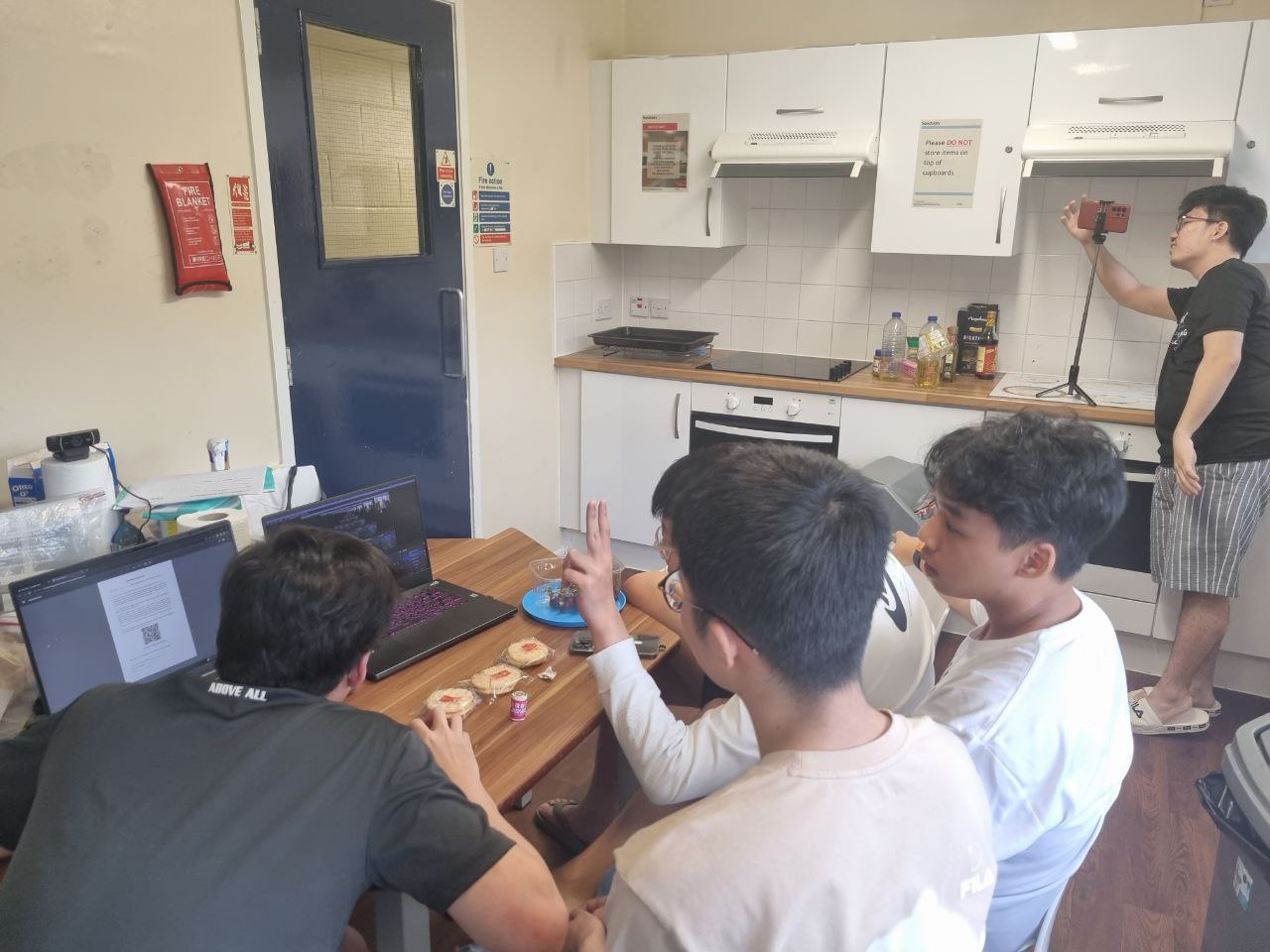
We have also worked on the static website as shown below:
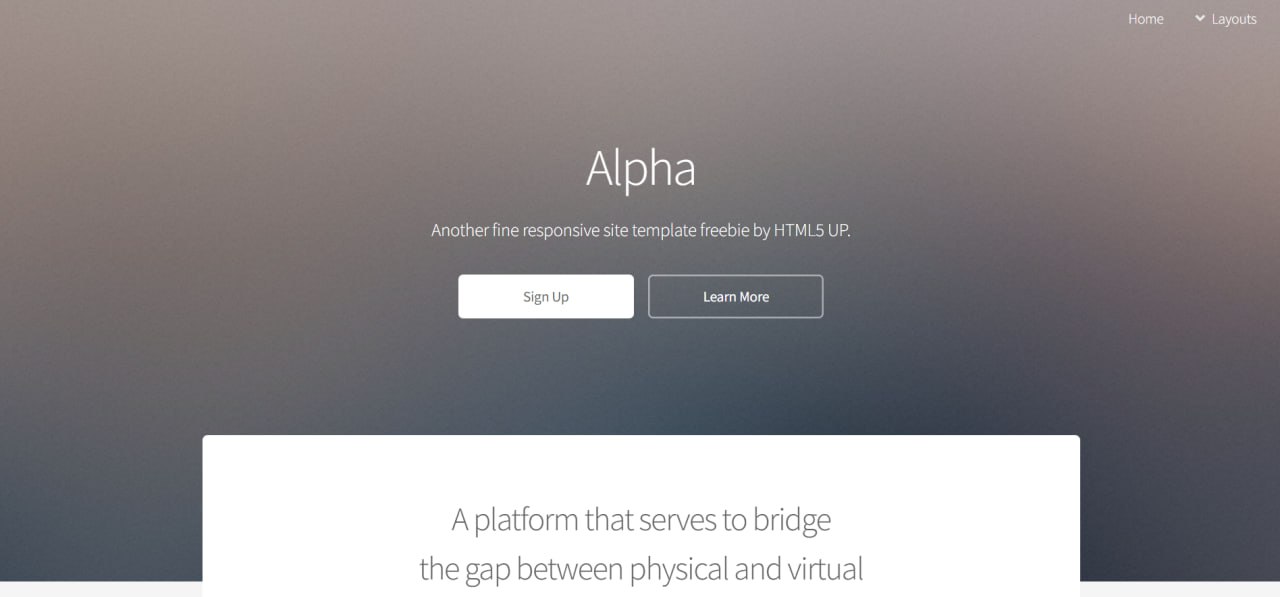
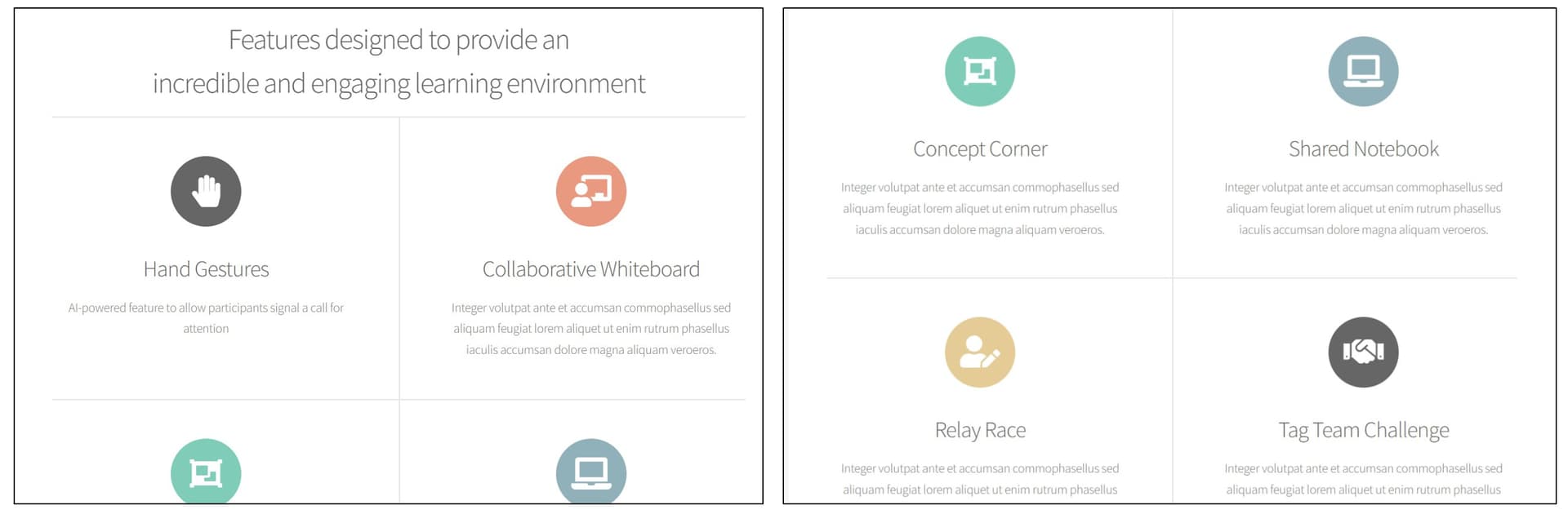
The team will work on the final touches for the poster and static website, to prepare for Thursday’s roadshow.
After working on the Weekly Pitch 2, the team continued to work on the prototype
to enhance
the current existing tools.
The picture shows a rough sketch of the enhanced activities :
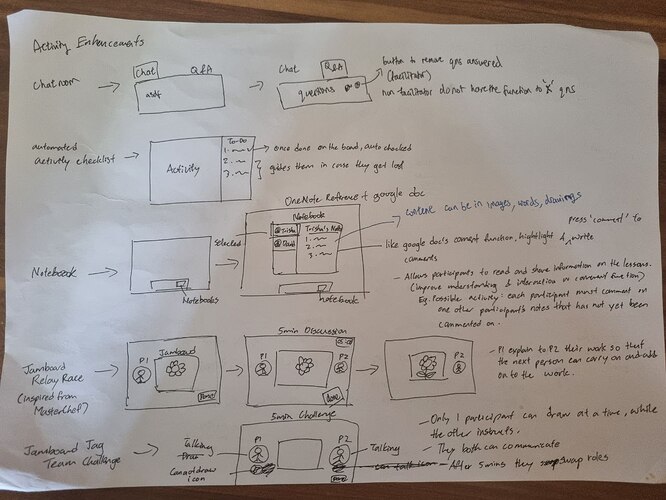
Chatroom:
The chatroom will contain a list of questions asked by both the Roomies and
Zoomies. Once the
questions have been answered, the question will be removed by the facilitator.
This feature
will not be visible to the others.

Automated activity checklist : (in progress)
The checklist will display the list of activities to be done by the participants
in order.
Once the activities are complete, it will be auto checked. This feature will act
as a guide
to the participants to know the current progress of the session
Notebook:
Similar to Google docs and OneNote, this feature allows participants to share
their thoughts
and information of the sessions. A possible activity that can be implemented is
to have each
participant comment on another participant’s comment.
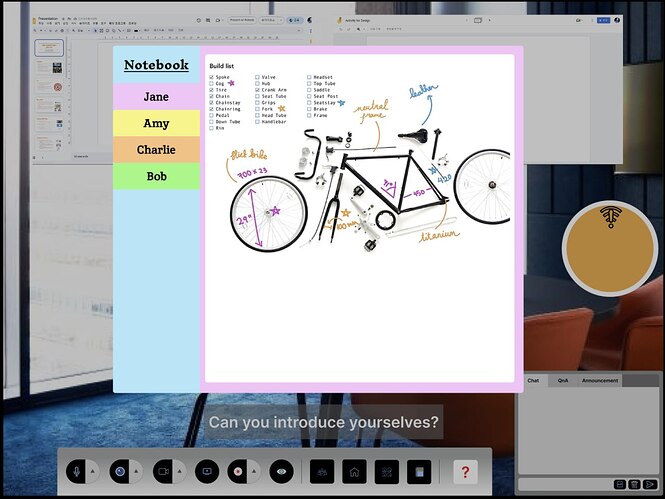
Jamboard - Relay Race activity : (In progress)
Inspired by MasterChef, a roomie and zoomie will be paired together(participants
1 and 2), where the first participant will complete a part of the task. After
which , they will discuss with the other participant , so that they can continue
to work on the task. The facilitator can assign a specific number of roomies to
be the participant 1, and the others to be the zoomies to prevent audio issues.
Another activity inspired from jamboard is the Tag team challenge, where the
teams will be given 5 minutes to work on the activity. 1 participant will draw
at a time, and the other participant can guide and instruct the participant.
After which, the other participant will continue the drawing.
In addition to these enhanced activities, the team will also be
adding on a few points under the housekeeping rules to be announced at the start
of the session by the facilitator:
- Participants must keep their audio on mute when not speaking to reduce background noise
- In case of technical issues during an activity, participants to inform the facilitator immediately
- Any form of disruptive or inappropriate behaviour will not be tolerated, and may result in removal from the session at the discretion of the facilitator.
I will include yesterday’s work in today’s daily as everyone was tired after
finalizing the design.
Yesterday, we had a final discussion with Professor and Team B about
miscommunication with the client. We have discussed on what was the issue, what
can be done and what was the requirement again.
After the meeting, we gathered in the Student Study area to discuss what should
we do. We have written the problem statement: “How might we engage zoomies and
roomies during the hybrid session”. Then, we started to look back into our
previous ideas such as Roblox, combining existing solutions, and writing the
guide. We then questioned ourselves if these ideas solve the problem statement.
Some partially did, and some did not. Hence, we decided to look back into
current situation first.
As we don’t know how Technology Coach’s hybrid meeting procedure is conducted.
We filmed ourselves trying the hybrid meeting. Despite the filming scenarios
were not professional, we could still identify some problems. Some of these
challenges identified were:
- The audio feedback effect when a voice from a speaker enters the mic and causes echos
- Difficulty of zoomie to join the conversation when roomies are interacting
- Facilitator has too many window tabs that he is confused about what to share, hard to control the speaker, mic of the roomies’ devices
- Difficulty to share and release screen which breaks the flow of presentations and affect privacy of individuals
Some ideas finalized were:
- Gesture Recognition in the video call
- Wearing a headset and roomies to spread out during group activities
- Art Gallery for groups to upload their work on a common room screen, which can be enlarged
Today, as some of group members are unavailable due to personal trips, rest of the team has focused on creating the Figma prototypes.
Some of the screenshot are here:
- Online meeting platform (GoBrunch)
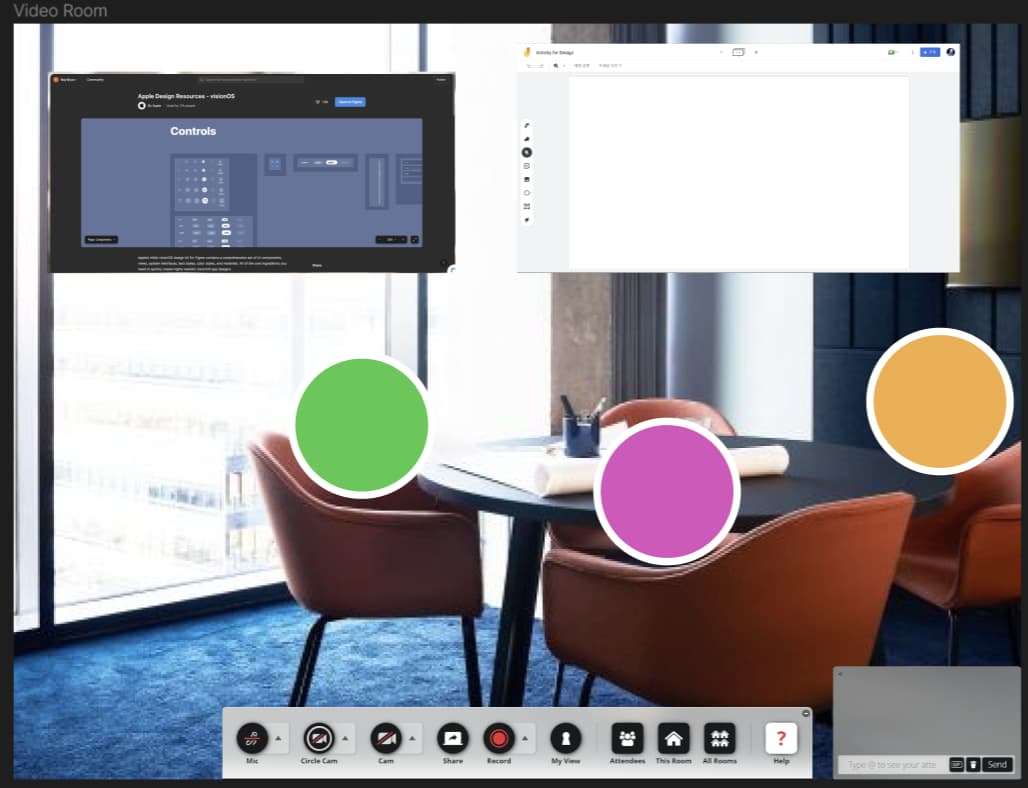
- Image of how roomies will be sitten and viewing the screen

- Process of Zoomie joining the conversation
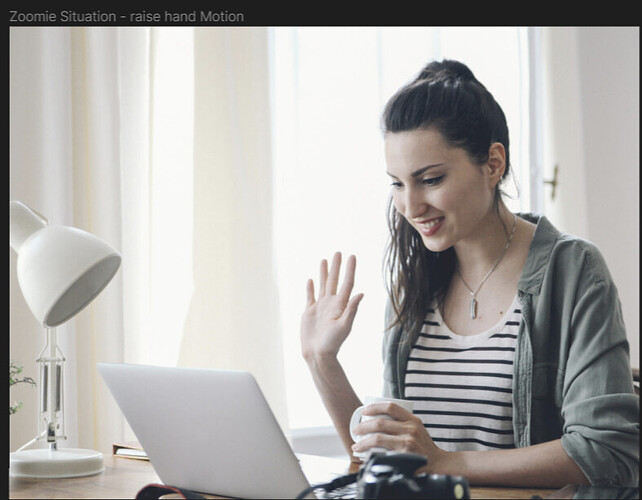
- A zoomie raising hand to alert the roomies that she wants to join the
conversation
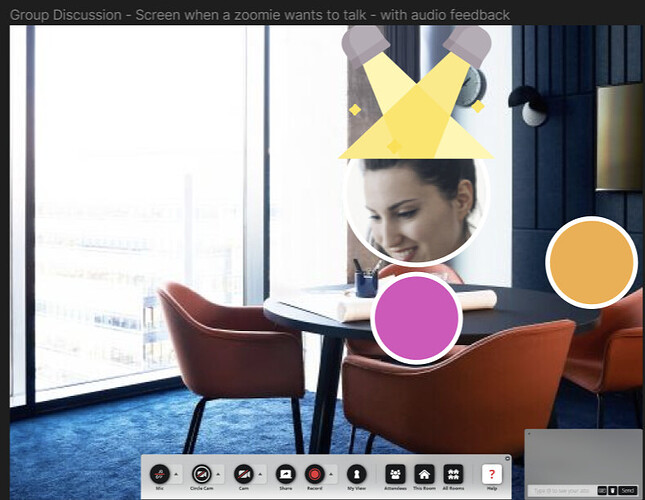
- The screen showing a zoomie receiving spotlight and audio alerts the
roomies. The roomies will hear and see the zoomie. Zoomie gets attention.

- Then we have added 1 more zoomie. The screen will show 2 people (1 off
camera) who are active in the conversation.
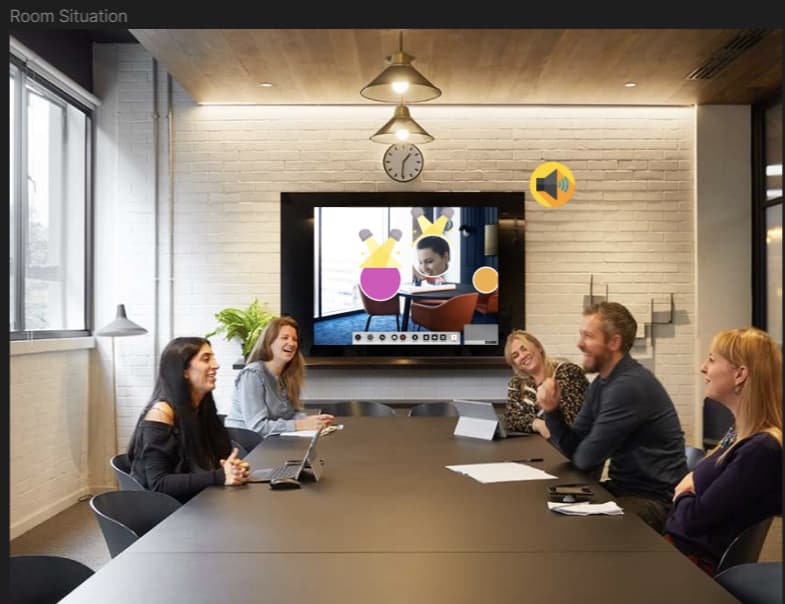
- Facilitator to control the roomies’ devices setting. The tablets which
roomies are using are provided by the client. Hence, these devices are safe
to link with the facilitator’s laptop. This dashboard will allow facilitator
to handle technical issues like audio echo quickly.

- Art gallery. Participants can form group, without caring being a roomie or
zoomie. The roomie will follow the housekeeping rule: wear headset and sit
apart during group activities. After they completed group activities with
using online collaborate tools like Jamboard, they will upload the file to
the Art Gallery. Then, their works are displayed as shown in the picture.
 Facilitator can click the displayed works to enlarge them, which will reduce the burden of participants sharing their screen.
Facilitator can click the displayed works to enlarge them, which will reduce the burden of participants sharing their screen.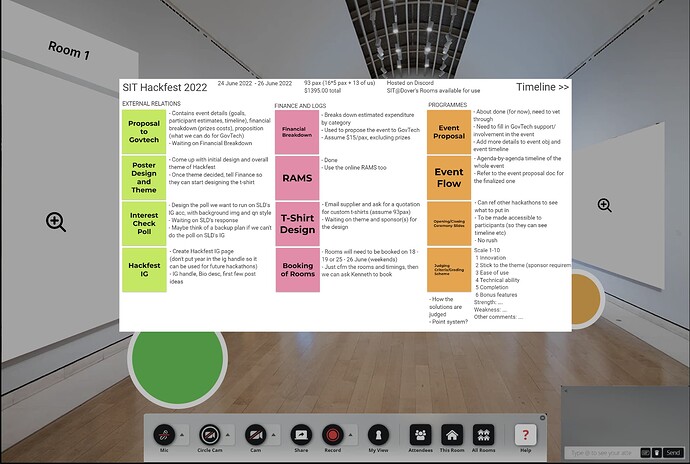
These are some of works done today. Tomorrow, we will amend these prototypes and create slides to take our weekly pitch 2. Some ideation yet to prototypes are regarding group activities like taking quiz in group.After that, we are looking forward to jumping into user testing, designing poster and lastly, website showcase.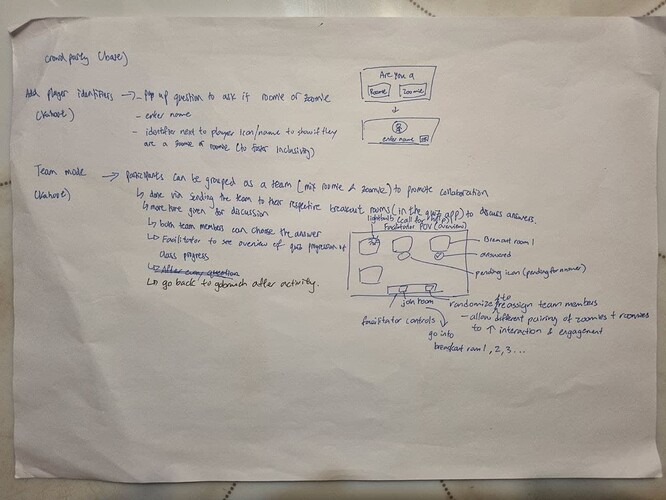
The team has gained insight from the discussion with the customer. It was noted
that our idea on using Roblox for an environment for the participants to join
the activities does not fit the demographics that the company is targeting.
Furthermore, it was highlighted that the methods of the lessons should not be
modified at any shape or form. The customer exclaims that the objective is to
provide a tool or a platform to conduct their lessons the same way as it has
always been conducted.
The customer has clarified that they do not want us to provide any insight or
analysis on the different existing tools to conduct hybrid or online lessons.
They already have an existing team to search for the different tools to use.
Essentially, we are to create a new tool or platform for the company to use and
to conduct their lessons for both roomies and zoomies, then we would have to
consider the value that it brings.
Hence, the team will pivot for another time and think of ideating a new platform
for the company to use. A few ideas have been thought of, generally we want to
provide a tool that is composed of different aspects of pre-existing tools where
it would bring much more benefits and one that fits their requirements. The
current plan of action is to create a figma of this new tool and we shall
demonstrate how this new tool would be beneficial for their objectives.
To-do:
- Design a new tool that has the benefits of most if not all existing tools
- Possibly a figma prototype to demonstrate how the tool operates
- Weekly pitch video on the prototype
With continued discussion among the group members, we have expanded on the
approach that we have pivoted towards. We have divided our efforts into two
different sections, one being the research on the different tools that may help
us with conducting the lessons and make the environment more conducive for both
the roomies and zoomies. The other group members would work on the role-playing
prototype, specifically on the script, content and the flow of the role-play.
The main aspect of the prototype is to showcase the flaws and difficulties of
the current methods of the lessons that are being carried out by the
facilitator.
For the research, we further investigated the tools we have previously found and
that were suggested by the customer. For the meeting platform, the highlighted
GoBrunch has already met all their significant needs to conduct a lesson and
communicate with the participants. For activities, we have taken a look at
multiple websites that are able to host quizzes, card games and team-building
games.
Most of the websites are homogenous, but the one that stands out above the rest
is CrowdParty. CrowdParty has the edge over the other websites because it is
highly customizable and it has a wide variety of activities that can be done
within the website which fulfils most of their requirements to conduct an
interactive lesson. Extensive research will be continued as CrowdParty is
already an existing option for the customer, perhaps we may find better options
for the customer to use for their lessons. However, quizzes can be carried out
on other websites that are made to host quizzes instead.
The two most superlative websites that we found and know are Mentimeter and
Kahoot! It is difficult to make a decision on which is better than the other as
Mentimeter provides a better data collection and representation for the
facilitator/host to use whereas Kahoot! provides a better user experience for
the participants. We shall continue to compare the two in detail while searching
for other possible options to host quizzes for the lessons.
For the role-playing prototype, the team has drafted out a script and props
required to enact the role-play depicting the current methods or environment of
the lessons that the customer is conducting. The team hopes that it helps us
learn better and understand the plight of the client, and come up with better
solutions and tools to slot into respective areas to help conduct a better
hybrid learning session. It is apparent that there are obstacles or constraints
that are out of our control to resolve. One such issue is the internet
connectivity that prevents the zoomies and roomies from having a seamless
experience within the classroom.
Through these activities, the team plans to create takeaways after each
prototyping to be documented into a guide to conduct better hybrid meetings.
To-do:
- Client meeting and seek for feedback
- Refine the role-play prototype and solution base on feedback
- Start filming of the role-play prototype
- Designing the static website
Our plan was to use Roblox as a platform where both Roomies and Zoomies can join
in to play activities together. From the prototype drawing, the roomies are able
to join in via tablets provided by the client, while the zoomies are joining
from their own devices. There are 2 general phases during the hybrid lesson -
slide and activities phases. For the slide phase, this is rather simple as
roomies will be looking at the large screen - where slides will be shown, and
the zoomies will be seeing from the Roblox virtual classroom. For the activities
phase, roomies will join into the Roblox environment where they can interact
with the zoomies to play cards, quizzes and communicate.
In order to show the idea, we had to build some sort of environment. Although
Roblox has the studio tools to build an environment, these tools take more time
to learn. Hence, we have chosen Minecraft to create such virtual classroom
environment to visualize how the slides and activities are carried out, while
managing interactive communications during the class.
Above were initial plans to carry out today. However, we have received an email
from the client that this may not be the product she wants because she wants to
look into existing solutions, before coming out with something new. Hence, we
consulted the professor on this matter during the lesson.
After the consultation, the team discussed and came up with the conclusion that
the client wants us to redesign her current lesson methods. Tools like GoBrunch,
Mentimeter and Crowd party are some of the resources used to make the lessons
more engaging between the roomies and zoomies (where roomies and zoomies do not
communicate with each other in their current hybrid sessions).
Hence, we will be role playing to act out on how the lessons are conducted, as
well as how the researched tools will help to address the challenges faced.
After discussing with the other team, we have sent out an email to the client to
confirm our ideation progress so that we could complete more tasks after the
meeting scheduled on this Thursday.
Today, we have reviewed the feedback from the professor and the tutor to
identify the areas that need improvement. The two main points mentioned were the
lack of details in the prototype and placing too many responsibilities on the
participants.
As a team, we gathered to discuss how we can address these issues and agreed to
design the prototype environment and simulate the learning processes.
Consequently, we explored different tools to build the environment:
- Roblox Studio: This platform allows us to create a 3D environment for Roblox, which aligns with our plan to use Roblox as the learning platform. However, it requires some time to learn the tools and apply them to make our prototype work effectively.
- Minecraft: This 3D world enables us to build an environment using blocks. While we won’t be able to link it directly with the actual Roblox, it seems to be the most reasonable platform to select for simulating Roomies and Zoomies and testing how communication flows.
- Acting out: This option is more affordable, but it’s also more tedious as it would require props, scripts, and the right environments to film the prototype flow. Nevertheless, it could be a valuable way to discover actual problems that may arise in a hybrid learning environment.
After careful consideration, we have chosen Minecraft as the ideal tool to build the prototype and have already explored hosting options for a server.
Lastly, we have sent an email requesting a meeting with the client and received confirmation for this Thursday at 10 am via Zoom.
The progress made for today is the start of the design and prototyping of the
solutions that we have devised. As previously mentioned, the two prototypes are
virtual sandbox environment and a digital collaborative environment.
Firstly, with the use of Roblox or similar sandbox platforms, we can host or
carry out hybrid lessons where activities such as flashcards and quizzes can be
done. The platforms provides a certain degree of interactivity between the
roomies and the zoomies due to the customizability. The presentation slides of
the lessons are shown on the screen from the projector for the roomies and the
zoomies can view the presentation slides on their own devices. Once the
prompted, the roomies are provided tablets or other devices to access the
virtual sandbox world to gather with the roomies and start their activities
together.
Housekeeping rules are erected so that there are no chaos or chatter between the
roomies and the zoomies, things such as turning off of microphones and taking
turns to speak.
The gap between the physical plane and the internet would be bridged with the
sandbox platform. We can create rooms or sections within the virtual world where
the roomies and zoomies can both enter and interact with one another.
Activities, games and quizzes can be carried out by the facilitator and a sense
of direct presence can be created between the roomies and zoomies.
The primary obstacle that comes with this solution is the communication between
the roomies and the zoomies. There is a question of whether the communication is
done through chat or audio. Audio will create a massive amount of chatter which
would lead to feedback or difficulty in understanding one another. This will be
looked into over the next few iterations of the design.
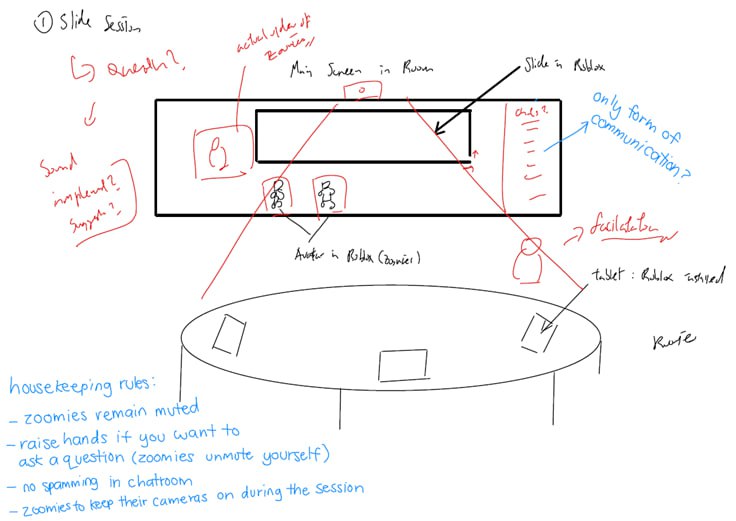
Our second prototype extends the capabilities of a tool like here.fm, to offer a customizable and interactive space that allows both remote and in-person participants to collaborate more effectively. The following are the features:
Admin Control: The admin has complete control over the digital environment. They can choose the background, add or remove furniture, and tweak the overall layout to suit the session’s needs. They also have the ability to manage permissions such as muting participants or turning off their video feeds.
Participant Interaction: Each participant has the option to engage via voice chat or video camera. They can also participate in chatrooms by typing if they prefer, offering a range of communication options.
Icon Representation: Participants are represented by icons in the digital space, making it easy to identify each other and engage in the virtual setting.
Advanced Admin Permissions: The admin can give other participants certain permissions as needed. They can also incorporate frames into the digital environment, which could include PowerPoint slides, quiz activities from platforms like CrowdParty, or other visual aids.
Screen Sharing: Participants have the ability to share their screens, making it easier to present ideas or work collaboratively on tasks.
Full-Screen Frames: Any frames shown in the digital environment can be expanded to full-screen mode, ensuring clear visibility for all participants.
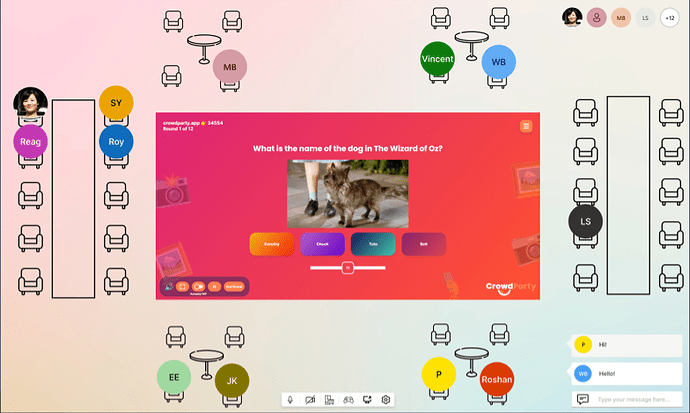
The team is excited to share today’s progress on the Technology Coaching
project. Building on yesterday’s requirement gathering and brainstorming
session, we explored various ideas to create an engaging environment for both
“zoomies” and “roomies.”
Initially, we considered using AR or VR to achieve the goal of bringing roomies
to be “zoomies” or vice versa, creating a sense of presence for all
participants. However, we went deeper into the concept and came up with an
innovative idea: using Avatars to represent participants in a shared digital
space, similar to the concept of MMORPGs.
The concept of Avatars in a cyber world, like MMORPGs, allows people from
different locations and time zones to come together in a virtual world and
interact with each other. We believe that this idea can be applied to online
learning, providing a platform where learners from anywhere can join a digital
space to learn and collaborate on educational content.
Two promising tools that emerged from our research are Roblox and here.fm:
Roblox: We explored Roblox as a potential learning platform that allows users to
create an account, customize their Avatars, and join various games within the
Roblox world. By combining Roblox with AR glasses, participants can immerse
themselves in the same environment, fostering a strong sense of presence. The
cyber world of Roblox also enables gamification of learning materials and other
interactive content. Additionally, Roblox offers voice and text-based chatting,
ensuring seamless communication between participants and instructors. However,
we need to address concerns related to potential players looking to perform
misconduct such as using censored words as names, and misbehavior within the
platform.
here.fm: Another tool we identified is here.fm, which offers a simpler and more
accessible solution compared to Roblox. Participants can select a background for
the website, and other participants are represented by simple colored circles
with their initials as nicknames. While here.fm lacks the sophistication of
Roblox, it still provides a basic digital space for interaction and
collaboration. Hence, this can be our reference for final design as we can
expand more ideas from this tool.
Lastly, we have started preparing for our video by creating sample slides.
I would like to provide a summary of our meeting with Mrs. Sooz from Technology
Coaching and share the progress we have made.
Here are the key points discussed:
- Project Aim: The goal of the project is to bridge the gap between tech-savvy learners (“zoomies”) and non-tech learners (“roomies”) in the hybrid learning environment. The main challenge is to design or utilize a tool that effectively engages both zoomies and roomies during the lessons.
- Learning Tools: Technology Coaching currently utilizes various learning tools both online and offline. Online tools mentioned include Mentimeter and Zoom, while physical tools include card games. It’s worth noting that the major learning method for the core six courses is gamification.
- Internet Connectivity: Some rural areas have weak internet connections, which poses challenges for hybrid classes.
- Privacy Concerns: Minimal information is collected from clients, but certain content may be inaccessible due to customer system restrictions. Tablets with pre-installed tools are distributed to learners, but limitations arise with the introduction of new technologies and expensive licenses.
- Participant Issues: Zoom housekeeping rules include turning on video and muting the microphone unless necessary. Some participants have limited familiarity with IT devices.
- Facilitator Challenges: Facilitators require skills to engage both roomies and zoomies. They also face the burden of carrying multiple devices such as internet routers and cables, as well as managing changing locations and timings.
- Q&A Session: We conducted a Q&A session to gain further insights into the attempts made by Technology Coaching to address these challenges.
- Approach: After sharing our findings with the professor and tutor, we have agreed that our main focus should be on creating an engaging environment where both zoomies and roomies feel like they are together in the same physical space.
- Challenges: We acknowledge that certain challenges, like internet connectivity, are beyond our control and cannot be solved within our limited time frame. Therefore, we will concentrate on feasible solutions within our scope.
- Next Steps: We plan to continue discussing the identified challenges and ideas this week to develop more detailed concepts before proceeding to mock-ups and proofs of work.
Today, we discussed the questions to ask Technology Coaching to discover users’ needs and requirements.
Questions:
- Can you provide an overview of the specific topics and digital disciplines covered in Technology Coaching’s training sessions? What are the key learning objectives for participants?
- What materials and resources are currently used during the training sessions to enhance engagement and collaboration? Are there any constraints or limitations in terms of accessing or utilizing these materials in a hybrid setting?
- Who are the primary target audiences for the training sessions? Are there any specific demographics or industries that Technology Coaching focuses on? (Age groups, technical proficiency of participants, and disabilities to assess the feasibility of the solution)
- Considering that participants come to learn and may not be technology experts, what strategies or approaches are currently employed to build their confidence and understanding of technology? Are there any specific challenges or areas where participants typically struggle?
- Has Technology Coaching made any observations or gathered feedback from previous hybrid training sessions? If so, what were the main takeaways and insights from those experiences? (Request for data)
- How do Technology Coaching’s face-to-face workshops and online training sessions differ in terms of content delivery and engagement techniques? Are there any challenges in maintaining consistency and interaction across both formats?
- Any specific requirements or preferences for maintaining a collaborative environment between “zoomies” and “roomies” during the hybrid training sessions? Are there certain tasks or activities that are particularly effective in fostering teamwork? (E.g. Technical limitations, communication barriers, or difficulties in maintaining interaction between remote and in-person participants)
- How do you currently assess participant engagement and understanding of the materials covered? (Metrics used to measure the effectiveness of the training sessions)
- Are there any technical or logistical/budget constraints that need to be considered during the hybrid training sessions? For example, limitations in internet bandwidth, equipment availability, or room setup for in-person participants.
- Are there any specific goals or outcomes that Technology Coaching aims to achieve in terms of engagement during the hybrid training sessions? How do these align with the broader objectives of the training programs?
- Is a technical solution or framework needed for the hybrid training sessions?